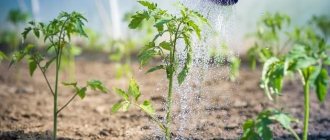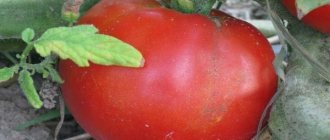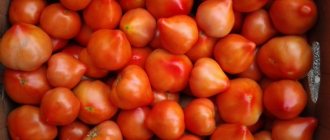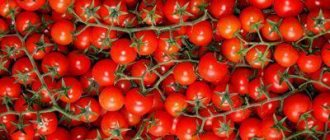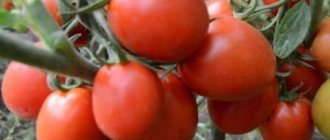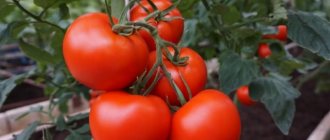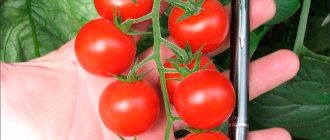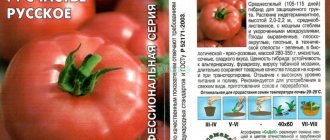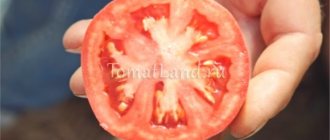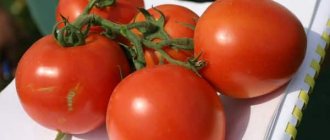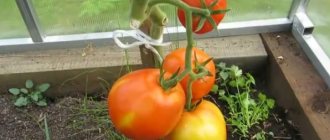» Vegetable growing » Tomatoes » Growing tomato Chief of the Redskins
0
1294
Article rating
One of the most popular super-early tomato varieties is the Redskin Leader tomato. It was bred by breeders from Novosibirsk - O. V. Postnikova and V. N. Dederko in 2005. The variety was added to the State Register in 2007.
- Advantages and disadvantages of the variety
- Seedling method
- Preparatory stage
- Sowing seeds for seedlings
- Seedling care
- Transplantation into the ground
- Seedless method
- Sowing seeds in the ground
- Watering
- Loosening and weeding
- Stepsonning and garters
- Top dressing
- Prevention of diseases and pests
- Harvest and storage
- Errors during cultivation
- Reviews from gardeners
Growing Tomatoes Leader of the Redskins
Brief information about the variety
- Fruits and bush : pink tomatoes, weight - 150-160 g, determinate bush, reaches 0.6 m.
- Productivity : up to 6 kg per bush.
- Resistance : the plant is not resistant to fungal diseases and pests, and tolerates frost well.
- Distribution : the variety can be grown in any region; in open ground - only in the Rostov, Volgograd and Krasnodar regions, Stavropol region.
- Application : fresh consumption, preparation of juices and sauces, tomatoes are rarely canned.
- Planting : seedling and non-seedling methods. In the first case, this is done at the beginning of May according to the 40x60 pattern, in the second - at the end of April or early May, the pattern is 40x60.
- Soil : nutritious and light.
- Care : watering - once every 7 days, fertilizing - 3 times per season, pinching is not required, garters are required.
- Ripening period : tomatoes will be ripe by August. Fruiting continues until the end of summer. Fruits are stored for up to 30 days.
Description of fruits
The description of the variety also presupposes a story about the fruit characteristics. As for the Bison tomatoes, we note the following:
- The ripe fruits are red in color, sometimes raspberry-pink, and have a rounded heart-shaped shape.
- The vegetables are not very large; the first ripened ones weigh 350 grams, and subsequent ones weigh 100 grams less.
- According to the number of chambers - quantity 4-5, content 5-6% of dry filling.
- The collected fruits can be stored for a long time, which is especially attractive for those who plan to grow a good amount of vegetables for sale.
- The variety has excellent taste, is very sweet, and is optimal for fresh consumption.
- Tomatoes are also used for making juices and pastes, and due to their compact size, tomatoes are good for canning as a whole.
See also
Description of the tomato variety Amurskaya Zarya and its characteristicsRead
When describing the Bison tomato, it should be said that there are several varieties of the variety. So, there is a determinate species called “Yellow Bison”. Reviews from experienced gardeners indicate that this species is preferably formed into two trunks. As for the vegetables themselves, their shape is flat-round, with a slight degree of ribbing.
Another determinate type option is “Bison Black”. It can reach 180 cm in height. The bush develops powerfully, so do not forget about special supports and garters. Those who have planted this tomato variety know that the fruits are not just tasty, but endowed with a special fruity aftertaste.
“Black bison” is optimal for salad use, but housewives do not recommend pickling it: the fruits in jars will crack.
Characteristics of the variety
The variety Leader of the Redskins is a hybrid. It was bred specifically for cultivation on private farms. Due to its very early ripening, this variety has become widespread.
Tatyana Orlova (Vasilidchenko) (candidate of agricultural sciences):
Since the variety is declared as super-early, its ripening period in open ground when planted in early May should be in early July.
The variety can be grown in any region of the country. All thanks to the high level of resistance to different climatic conditions. Bushes of this variety are able to tolerate droughts that are not too long.
Description of the bush and fruits
Redskin Chief is a determinate variety. The height of the bushes is no more than 60 cm. They are characterized by an average degree of foliage. The leaves are dark green. Inflorescences of a simple type.
The fruits of this variety have a flat-round shape. They are pink in color. They are characterized by slight ribbing. The average weight of one fruit is 150-160 g. The tomatoes are fleshy, but not too juicy and a little loose.
Productivity
According to the description, the yield indicators of the variety are quite high. From 1 m² you get up to 6 kg of tomatoes. The fruits on the bushes are collected in clusters of 3 to 6 pieces.
It is better not to plant more than 3-4 bushes in such an area. Then they will be able to develop normally and delight in the level of their fruiting. Tomato ripening occurs on days 80-85.
Application of fruits
Redskin Chief is a variety grown for salads. Tomatoes of this variety are used to create sauces. They are often used to make juice.
The fruits are often consumed fresh; they are rarely canned. Due to their size, tomatoes are great for this because... They are easy to place in jars whole.
Resistance to diseases and pests
Particularly high resistance to pests and diseases was not found in the variety, so its cultivation must necessarily be accompanied by preventive measures. It is better to start them after planting (about 20 days).
Such events are held once every 2 weeks. This is necessary to get a good harvest. If prevention is not done, the plant can quickly dry out due to any disease or pest.
Growing regions
The variety can be grown in any region
This variety is suitable for growing in any area, but not in all regions open ground will contribute to the good development of the crop. The most suitable areas for growing this tomato are the Volgograd, Rostov and Krasnodar regions, as well as the Stavropol region. The climatic conditions in these regions allow tomatoes to be planted in open ground in beds.
Those who grow tomatoes in the northern regions of the country may encounter minor difficulties. There is a harsher climate and short summers, so it is better to cultivate tomatoes in greenhouses.
Central Russia is a territory that provides for the use of film shelters when growing tomatoes of this variety. In this case, you can immediately plant the plant in the greenhouse.
Advantages and disadvantages of the variety
Compared to other varieties, the Redskin Leader variety does not have many advantages, so most often those who planted this tomato once rarely grow it again. Description of the advantages of culture:
- good yield indicators;
- Possibility of breeding in greenhouses and open ground.
- short shelf life;
- satisfactory taste characteristics;
- low resistance to diseases and pests;
- many fruits have some defects due to which they must be discarded if the tomato is grown for sale.
Seedling method
When growing Red Chief tomatoes, it is important to prepare the seeds. Only after this they are planted in the ground for growing seedlings. In this case, seedlings must be planted 60-65 days before they are moved into the ground.
It is better to sow the seeds in a common container and then pick. This procedure is only possible for seedlings that already have 2 leaves. The place where the seedlings will be kept should be as sunny as possible. It is important to provide it with an optimal temperature - no more than 21 °C during the day and 16 °C at night.
Preparatory stage
Preparing seeds for subsequent growing of seedlings begins with their selection. To check, fill them with heated water. Those that float can be thrown away.
Next, the selected seeds are poured with a weak solution of potassium permanganate. They are left in it for 15 minutes. for disinfection. The seeds must be dried before sowing.
Sowing seeds for seedlings
Prepared seeds are sown for seedlings in special containers. They are filled with garden soil mixed with fertilizers. River sand and humus are also added to it. The ratio is 2:1:1.
Shallow grooves are made on the surface of the soil (1-2 cm is enough). Place the seeds in them, the distance between them should be 2.5-3 cm. Then add a small layer of soil (about 0.5 cm). You definitely need to water the soil, but so as not to deepen the seeds.
Seedling care
Seedlings need a lot of light
Film will help speed up seed germination. It is used to cover the seedlings until they sprout. The seedlings will need to be ventilated daily for 15 minutes.
Tatyana Orlova (Vasilidchenko) (candidate of agricultural sciences):
Covering the crops with film or glass helps retain moisture in the soil while the seeds germinate.
Seedlings need to be sprayed. This procedure is performed with such frequency that will not allow a crust to appear on the soil surface. The plant should always have access to sunlight, so for night time you will need to purchase special lamps.
Tatyana Orlova (Vasilidchenko) (candidate of agricultural sciences):
The duration of daylight hours for tomato seedlings is 12-14 hours. At the beginning of spring, daylight hours are shorter; artificial light lamps illuminate the seedlings for another 2-4 hours.
When the seedlings reach a height of 7-9 cm, it is recommended to pick them.
Transplantation into the ground
Plants whose height has already reached 30 cm are allowed to be replanted into the ground. It is important that the soil is already prepared by that time. It will need to be fertilized a little with peat, which makes the soil nutritious and lighter.
Tatyana Orlova (Vasilidchenko) (candidate of agricultural sciences):
Peat is not a fertilizer. It contains few nutrients, but has good physical properties: looseness, lightness, moisture-holding capacity. To increase soil fertility, other organic substances are used - humus, compost.
Before applying fertilizer (peat), the soil must be dug up. The optimal digging depth is 20 cm. Use 2.5 kg of peat per 1 m². After this procedure, they proceed to digging holes.
The recesses should be placed at a distance of 40 cm from each other, and the rows should be 60-70 cm. Do not make the holes too deep - a shovel bayonet will be enough. It is important that the root system is evenly distributed throughout them. Do not plant plants too deep. Make sure the leaf growth line is above the ground.
After placing the seedlings in the hole, fill it with soil and water it (1 liter of water per bush). You can then moisten the tomatoes after 7-10 days.
Tomato "Leader of the Redskins"
The fruits are round-flat, smooth, red in color, can reach a weight of up to 700 grams, very beautiful, exceptional yield and disease resistance. The fruits are sweet, dense, fleshy.
Read also: Photos and descriptions of Crimean mushrooms
A salad variety, used for fresh consumption and processing.
Growing tomatoes from seeds
Many are sure that in order to obtain early tomato production, seedlings need to be grown as early as possible. But in an attempt to obtain the earliest harvest, they forget that seedlings require ideal growing conditions - light, heat, humidity in a certain range. It is almost impossible to create such ideal conditions at home.
As soon as the air temperature rises a few degrees from the required value against the background of a lack of lighting, the sprouts immediately begin to stretch, become thin and frail, which can threaten them with death. And planting tomato seedlings in February threatens to turn into just such a disaster. Convincing results were shown by an experiment I conducted, in which seedlings of the same variety, planted in February, bloomed on the 70th day, and those planted in April - on the 40th!
For example, the planting season in the climatic zone of northern Ukraine begins in early April. The seeds are immediately planted in an unheated greenhouse. The heating is turned on only if there is a threat of frost and a sharp drop in air temperature for insurance.
Before sowing, the seeds must be soaked until they swell, then they are pickled in a fairly strong solution of cherry potassium permanganate for about 20-30 minutes. To do this, the swollen seeds are laid out in containers (cups) and filled with a solution of potassium permanganate or a solution of a stimulant drug.
Experience shows that seeds (especially stale ones) that are not soaked before this procedure may lose their germination capacity after being treated with potassium permanganate.
While the shifts are in potassium permanganate, they are mixed several times with a stick, and then thoroughly washed either twice in different containers, or with running tap water. Afterwards, the tomato seeds are dried until they flow and are sent to the greenhouse for planting.
In the greenhouse, tomato seeds are planted on previously prepared, leveled and soft soil.
Shallow furrows with an interval of 10 cm, depth and width up to 1 cm, are where the seeds of future tomatoes are laid out.
After sowing, the seeds are carefully covered with a thin layer of soft soil (no more than 5 mm), sifted through a fine sieve. This method allows you to eliminate uneven and excessive deepening of seeds, which almost always happens if they are simply covered with soil. Properly sprinkled seeds provide uniform and rapid germination.
The first time watering is done only with a hand sprayer, because regular watering leads to the displacement of seeds from the planting site due to their washing away. But when the earth settles, the second watering can be carefully carried out using a watering can. Until the shoots appear, you need to water every day, because... the soil does not have time to absorb moisture and dries out, forming a dense soil crust, which becomes a difficult obstacle for tender seedlings.
When all the seeds germinate, you can remove excess and weak sprouts that can thicken the planting, leaving a distance of 1-2 cm between seedlings. Otherwise, the seedlings can become very thin, elongated and fragile.
As the future crop grows, soil is added 2-3 times between the rows in a layer of 3-5 cm, which makes it possible to somewhat restrain the growth of seedlings and stimulate the formation of additional roots. At the same time, the stems become stronger and more powerful, because the upper soft soil better retains and absorbs moisture. Seedlings grown in this way take root well after transplantation and, therefore, then show excellent results.
If the seedlings are strong and problem-free, then you should not get carried away with fertilizing at all. Feeding will be required only if the seedlings do not have time to strengthen and grow to the desired size by the time of transplantation. In addition, you need to remember that growing conditions in a permanent place in the ground should be better than in a nursery, so that the process of rooting, growth and flowering is not disturbed.
Then systemic feeding will come in handy, but only with the help of environmentally friendly substances, for example the drug EcoGumat plus ovary
.
Planting in the ground is carried out only after the threat of frost has passed, usually after May 20. Rows for tomatoes are marked with a wooden marker according to a certain pattern.
Row spacing for low-growing varieties should be 70 cm, and for tall varieties - 100 cm. In each row, low-growing varieties are planted with an interval of 30-40 cm, and tall varieties - after 40-50 cm. For tall varieties, a trellis is pulled on stakes 2-3 tiers, for subsequent garter, for example, with jute twine.
With this planting, tomato bushes are well ventilated, morning dew and excess moisture do not linger in them, which in itself prevents the occurrence of many diseases and helps to increase disease resistance.
Tomatoes equally dislike both cold and extreme heat and drought. They quickly become weakened, die, and the harvest is lost. Therefore, strive to provide tomatoes with more comfortable conditions for growth. In addition to the correct choice of planting site, fertilizing, processing and watering, to increase the natural immunity of tomatoes, the soil around the roots must be mulched with any available material. The most ideal substrate for this purpose is pine needles or wood chips.
Prevention and treatment of tomato diseases
It is important to remember that plants very quickly get used to any drugs and become more and more resistant to them each time. Therefore, each time you need to treat tomato bushes with different preparations. For example, 5 days before planting seedlings in the ground, they are usually treated with a systemic fungicide from a sprayer. Fitosporin are well suited for these purposes.
.
Stolbur or Phytoplasmosis of tomatoes, which has recently become very rampant, the causative agent of this scourge is not carried by seeds, it quickly dies in plant debris, however, it can persist on perennial weeds, especially field bindweed. It is spread by cicadas, whiteflies, moths or aphids.
Read also: Kale: what is it, how is it useful and how best to use it
Around the tomato plantings, it is advisable to plant plants with a strong aroma, which flying disease carriers do not like. The most common flower - Marigold (Chernobrivtsy) - can become such a convenient and faithful protector of your tomato plantings.
Seedless method
In this case, a little soil preparation will be required. If seeds are sown in unprepared soil, they may not germinate at all. The ground must be dug up to the depth of a spade bayonet, 1 m².
Fertilizers are applied. For the seedless method, it is better to use wood ash (0.5 kg), peat (3 kg), superphosphate (70 g). The optimal depth for introducing these substances is 20 cm.
Sowing seeds in the ground
After preparing the soil, you can sow seeds into it. The main thing is that it warms up to 15 °C. It is desirable that the air temperature is 20 °C. Typically this period falls in April-May.
Holes are dug in the soil, 5 cm deep and 30 cm in diameter, the distance between which should be 40-50 cm. 3-5 seeds must be placed in each hole. Next, they are sprinkled with soil and then watered abundantly.
Immediately cover the area with film. It is allowed to remove it only after the emergence of shoots. Next, dark plastic bottles filled with water are placed between the crops. All this is covered again with film. You can remove it when the bushes grow to it.
Watering
Watering is done once a week. During heavy rainfall, it is temporarily suspended, and in its absence, it is increased to once every 3-4 days. The plant loves good watering - the water consumption per bush should be 5-6 liters.
Before flowering, watering is done 2 times a week. When forming the first tomatoes, the procedure is done once every 3 days, spending 2 liters of water per bush. When the fruits begin to turn red, water the crop again once a week.
Loosening and weeding
After each watering, be sure to loosen the soil. This allows for improved air circulation. It is important that oxygen also reaches the root system.
In this case, water will not stagnate in the soil. The plant will receive all the substances it needs. Pests will not accumulate in the soil. Loosening helps prevent the development of certain diseases in tomatoes.
Errors during cultivation
The most common mistake when growing tomatoes of this variety is the lack of garters. Since the plant rarely produces fruits weighing more than 160 g, it is mistakenly believed that it can cope with such weight on its own.
The variety has good fruiting, but the bushes are not powerful enough. For this reason, the shoots begin to bend under the weight of the fruit. Productivity often decreases, and the plant itself develops worse and may wither.
It is important to water tomatoes correctly. When preventing pests and diseases, you need to alternate the substances used. Many do not, and as a result, pests and diseases develop immunity to certain agents. Because of this, the effectiveness of the measures is significantly reduced.
Characteristics of the variety
The applicants and originators of the variety are individual entrepreneurs Dederko V.N. and Postnikova O.V.G. Novosibirsk. In 2005, the variety was submitted for testing to be included in the register of varietal achievements. Varieties were tested over two years, and in 2007 the variety was entered into the register of varieties of the Russian Federation under number 9463982.
The variety is recommended for cultivation in all territorial districts of the country as an average ripening period. After testing, “Leader of the Redskins” was found suitable for growing in gardens and beds on citizens’ private farms as a salad tomato.
Description of the bush
Determinate variety. The height of the plant does not exceed 60 cm. When growing this variety, there is no need to stake it, but it is necessary to tie up the bush.
A medium-vigorous plant with dark green foliage produces simple inflorescences.
Description of the fruit
The fruits of “Redskin Leader” are flat-round. Some packers, when selling seeds, draw heart-shaped fruits on the bags and thereby mislead vegetable growers. Moreover, I managed to write “Sugar Buffalo” in quotation marks next to the name “Leader of the Redskins.” The only similarity between these varieties is that they are both determinate.
Tomato fruits of this variety:
- pink;
- flat-round;
- ribbed;
- have 4-6 nests;
- weight within 150-160 g.
The tomatoes are medium in density. But the reviews from those who have already managed to grow tomatoes are not very attractive.
The tasting committee determined the taste of the tomato to be “good.” Not all vegetable growers evaluate taste indicators this way. The tomato is not sour, many agree with this. Some even say that its sweetness appears in unripe fruits. However, this is where the delights of taste end. The variety cannot be called tasty; it does not have any special sophistication or alluring pleasure. Being a salad product, it is suitable for salads with a filling that will add piquancy, but as an independent product it is not suitable.
Advantages and disadvantages
Unfortunately, it is impossible to describe the advantages of this variety. Tomato “Leader of the Redskins”, the characteristics and description of the variety by those who have already planted it come down only to a description of the shortcomings. Having planted once, vegetable growers forever refuse to grow this tomato.
- low yield;
- not expressed taste properties;
- poor keeping quality;
The disadvantages can also be added to the fact that from the collected fruits there are a lot of non-marketable tomatoes, not standard ones, with defects, due to which many fruits should be discarded.
As a result, such products can only be used for sauce or ketchup, but after stripping. However, the pink color will not even allow the sauce to acquire a beautiful presentation, but its consistency will be thick.
About the specifics of caring for the Bison tomato
For Sugar Bison tomatoes, the region where it will be grown is not of fundamental importance, because it is a greenhouse variety. Preference, of course, is given to the central and southern regions. It is very important to know that this variety of tomatoes is characterized by increased resistance to lack of moisture, which means that excessive watering is contraindicated for it, and special attention should be paid to this.
The bush must be pruned when growing it, and the formation, as mentioned above, is best done in two stems. A branch garter is also necessary to avoid the risk of breaking them off. In terms of fertilizing, the variety respects them very much, especially the options with potassium, nitrogen and phosphorus. There is also a regular organization of ground weeding, and the peculiarities of watering are not abundance, but timeliness.
The main enemy of all tomatoes is considered to be the greenhouse whitefly. There is a good modern remedy for it – the drug “Confidor”. To quickly eliminate brown rot, which can cause trouble for this variety, just take note to immediately remove infected tomatoes, reduce the amount of nitrogen fertilizers, and water more moderately. The results of supervision are consolidated with the drugs “Hom” and “Oxis”. For prevention, it is important to temporarily ventilate the greenhouse and regularly harvest new crops.
See also
Description of the tomato variety Louis 17, features of cultivation and careRead
Resistance to diseases and pests
During registration, the commission did not indicate the particular resistance of the variety against any diseases. This suggests that the variety requires preventive treatments against fungal diseases.
Depending on weather conditions, treatment must begin 15-20 days after planting the seedlings, and then with a frequency of 1 time every 15-20 days.
When carrying out processing, you should adhere to the following rules:
- drugs should be constantly alternated, this will not allow the microflora to become addictive;
- when selecting fungicidal preparations, you should carefully look at the expiration dates in order to avoid delays and ineffective treatments;
- When preparing solutions, you should always follow the instructions for the drug;
- if the moment of ripening comes, and the weather favors the proliferation of fungal infections, you should select a drug with a short waiting period from the moment of processing to the moment of consumption of the product.
Characterizing the variety
This variety is characterized by medium ripeness, indeterminateness, that is, unlimited growth, and high yield. Tomatoes are indicated for growing in greenhouse conditions.
As for the bush, it is distinguished by its considerable size, sometimes reaching up to two meters. On the 6th or 7th leaf, the formation of an inflorescence begins, and then each pair of leaves. Formation into 1 or 2 stems is optimal. Depending on your choice, there are nuances regarding stepsoning. If the plant is formed into one trunk, then all stepsons must be eliminated; and in two - they leave the stepson, which is located above the initial brush of the flower.
The bushes will allow the first test three and a half months after the seeds have sprouted. Despite the height of the bushes, they do not have a large number of foliage, which means that the tomatoes will not experience a lack of sunlight during their ripening. E
If you follow all the care instructions, then each bush will share with you about 25 kilograms of delicious harvest over the course of the season.
Features of growing the variety
Growing seedlings
Sowing seeds of this variety is carried out at the usual time for your zone. Sowing can be carried out in a common container, and in the phase of 2 true leaves, diving can be carried out into individual cups.
If a universal soil for seedlings, prepared by specialists, is selected for growing seedlings, then the plant will not need fertilizing during the period of growth in containers.
The best temperature for growing is 18-21 ᵒC during the day and 16-17 ᵒC at night. In this case, the growing place should be sunny. Such parameters will not allow the seedlings to stretch.
Transplantation into the ground
As soon as the garden is ready to accept tomato seedlings, and by this time they should be 25-30 cm high and 55-65 days old, they can be transplanted into open ground.
If the seedlings were grown in individual cups, then replanting is carried out simply, without stress for the plant, using the transfer method.
If the seedlings have an open root system, then replanting should be done quickly, deepening the plant down to 4-5 leaves.
If the seedlings are overgrown, then they can be planted sideways or lying down. In this case, the shoot will give additional roots, which will increase the feeding area.
When choosing landing sites, preference should be given to the following location:
- light;
- protected from the prevailing winds;
- without nightshade predecessors;
- with soils of light mechanical composition;
- with high nutritional value of the soil.
Tomatoes are a very responsive crop. Leaving the garden unattended, the vegetable grower cannot get a harvest, because the plant will constantly be influenced by climatic factors, as well as pathogens and pests.
Important for tomatoes:
Since “Leader of the Redskins” tomatoes are not very productive, they do not require special fertilizers or fertilizing. But the shoots and the fruit need to be tied up. This variety produces, albeit a little, large fruits and their fixation to the shoots must be reliable. For tying, you can use soft string or twine, and work should begin from the moment of planting in open ground.
The choice of tomato variety is an individual matter for each gardener, but by listening to the experience of those who grew it, you can make the right choice of a productive and tasty variety. Give preference to the best of the best, and such varieties will always remain favorites in the garden.
Features of growing tomatoes
sowing the seeds of this tomato for seedlings 50-55 days before the intended planting in the ground. Seedlings dive at the stage of two true leaves. When planting seedlings in a permanent place per 1 sq. It is recommended to place up to 5 plants per meter of plot.
Further care for tomatoes consists of timely watering, fertilizing with complex mineral fertilizer, pinching and preventive measures to protect against diseases and pests.
You can see other interesting varieties and hybrids of tomatoes with photos, descriptions and reviews in our Tomato Catalog. Enjoy watching.
How to form a low-growing tomato, video
If you grew Redskin Leader tomatoes, please write whether you liked them or not. What was the yield and taste of the fruits like under your climatic conditions? How do you rate the disease resistance of this hybrid? If possible, attach a photo of your tomatoes to your comment. Thank you!
Your reviews of the Redskin Leader tomato and additions to the description will help many gardeners evaluate this hybrid more objectively and decide whether it is worth planting or not.
Description of the tomato Leader of the Redskins F1, reviews, photos
An early-ripening, productive, low-growing tomato hybrid for open ground and film shelters. In the southern regions, this tomato is planted without seedlings, directly into the ground. The period from germination to the beginning of ripening is 80-85 days.
The bush is of a determinate type and requires tying to a support and partial pinching. We recommend forming up to the first flower brush. Can be grown without pinching.
The first brush is formed over the 5-6th leaf, each subsequent brush is formed through the leaf.
Fruit characteristics
The fruits are flat-round, dense, red in color at maturity, weighing 120-150 grams, fleshy, good taste for a hybrid. These tomatoes are suitable for early fresh salads, processing into tomato products, and home cooking.
This hybrid tolerates short-term cold snaps well. Thanks to its early ripening, it manages to harvest before the onset of cold nights and, accordingly, the onset of late blight.
The yield in a film greenhouse is 9-11 kg of fruits per 1 sq. meters of landings.

